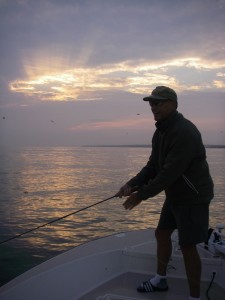Striper Fishing- Season To Date Report
Most of us have the limited perspective of the quality of fishing in our own area, but stripers do range up and down the coast. With all the concerns raised last year about the latest striper population estimates and the effectiveness of the reduced bag limits, Stripers Forever decided to survey some folks we know along various parts of the coast and find out their impression of how striper fishing is going this season. Here is what we found.
Striper Fishing: Season To Date Report
by Brad Burns President of Stripers Forever
For the 2015 season the Atlantic States Marine Fisheries Commission – the regulatory body responsible for managing East Coast striped bass – reduced coastal catches by about 24% and the harvest in the Chesapeake Bay producer area by 20%. This was done in reaction to a stock assessment that said the striped bass population was declining and was likely to decline further because of a continuing trend of moderate to very poor year classes of young fish. According to the ASMFC this reduction had only a 50% chance of reversing the population decline. Some of the northern states really wanted something much more stringent, while the commercial fishermen in Chesapeake Bay wanted no reductions at all. Things were bad enough in the coastal states, which are coming to realize the value of the recreational fishery that they have already in good part lost, that the pro conservation votes prevailed and the measures were in enacted.
With that in mind, how is the 2015 season going so far, and what is the prognosis for the future?
I poled the Stripers Forever board members, a group that include some highly experienced fishermen, guides, outdoor writers, and veterans of many fishery management boards and advisory groups. The question was “how is the striper fishing going in your area” trying to look at the breadth of sizes and areas of congregation. The responses I received ranged from Maryland to Maine, but they were remarkably consistent.
In a few words, the striper fishery can be summed up as inconsistent at best and continuing to trend downward. Northern New England – north of Cape Cod – has a fair number of small fish. Some folks are regularly catching small stripers, but it is a faint shadow of the school bass fishing 10 years ago. One guide from the North Shore of Boston area had a couple of solid days in June on the school bass he specializes on catching with light fly rods, but then has had tiny catches and even blank trips the rest of the summer. In Massachusetts waters, a couple of momentary hot spots excepted, large stripers are very hard to come by. Stripers, though, are a school fish, and if you happen to be where they are right now then you have good fishing. One very experienced fisherman from MA reports that what was once a Cape-wide summer fishery for large bass has been reduced to one good-sized school showing here and there unpredictably, and being pursued frantically by highly-mobile, opportunistic fishermen getting upwards of $6.00 per pound! A regular Cape Cod outdoor writer reported recently that some commercial permit holders he was talking to had given up because even with the high prices they just can’t find enough fish to make it worthwhile to go out.
Fishery managers have placed much of their hope for the future in the 2011 year class, which this summer represents fish in the 18” to 24” range. Most of the reports I got were that these fish are showing in decent numbers here and there. They are actually said to be more numerous than the smaller fish, which is not the way it is supposed to be. Still, the number of these 2011 fish, which are supposed to represent one of the biggest year classes of modern times, just doesn’t live up to the billing.
Things aren’t any better down in Jersey where one crack, lifetime surf and boat striper man said this: “I fish from the shore and from my boat in central NJ and the fact that I caught one striper over 20 lbs. this year as compared to 125 over 20 lbs in 2011 about sums it up. For me this was the worse it has been in about 30 years.”
The brightest report I have is from a friend in Maryland who also knows his striper fishing. Admittedly my friend works for the Maryland Dept of Natural Resources, but he tells me that while larger fish are lacking in the Bay, that sub 20-inch stripers – these would come from what are officially quite small year classes – are quite numerous, and that while the charter boats aren’t happy the light tackle anglers are having a ball. He also said that while there is nothing official yet the young of the year for this year appears to be looking up.
So what does all this mean? When will this fishery turn around? The answer is, based on the fish that are already born, that it won’t. The average young of the year count in Chesapeake Bay from 1995 through 2005 was 21.06. This was the pinnacle of the striper boom. The average from 2005 to 2014 dropped to 9.73. That means that there were only about 40% as many young stripers born during the last decade as the one before. More ominously, during the last three years that number has been an average of only 3.52 which is just 15% as many. If we are looking at a declining fishery now, imagine how it will look when the last of the fish born during the boom are gone.
Why are the year classes smaller now than 15 years ago? No one knows the answer to that for certain. It could be the effects of myco, of pollution in Chesapeake Bay, the wrong kind of weather, or killing too many of the large breeders. Stripers have always been sporadic in their spawning success, and that is why nature had these large female breeders carry so many eggs and live such long lives – to spawn many times. This would carry the striper population’s spawning potential over the naturally occurring weak reproductive years. We really don’t understand how important the size of the spawning stock biomass is to the potential of striped bass to produce good year classes. But it certainly seems counter to the biology of the creature to be directing so much harvest at these large old breeding fish.
A more risk adverse approach would be to not kill any of these big fish until the population recovers and then to kill relatively few, taking the harvest instead from smaller fish, since something like 20% of these will die each year of natural causes. This is exactly opposite of the way we have been doing things. It appears that one way or another we will eventually stop harvesting so many large fish, simply because there will be so few left to catch.








